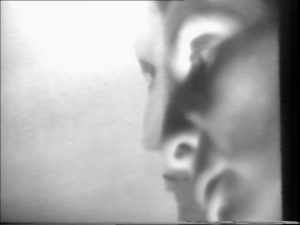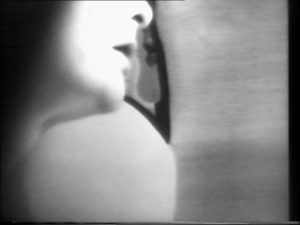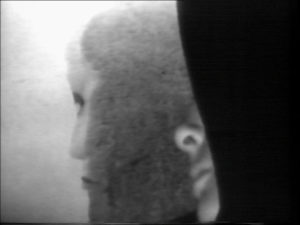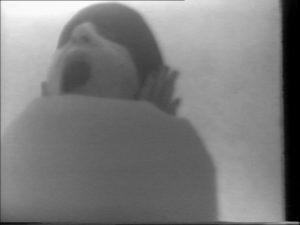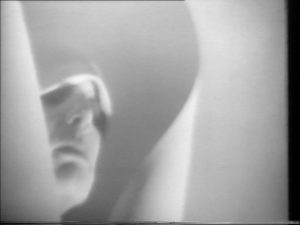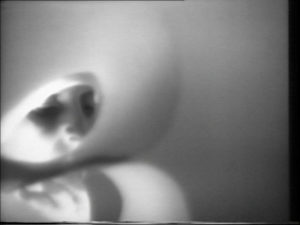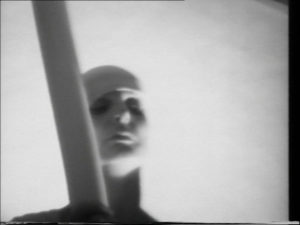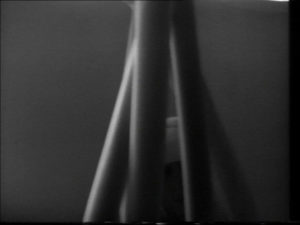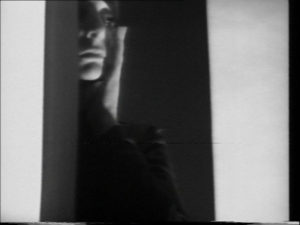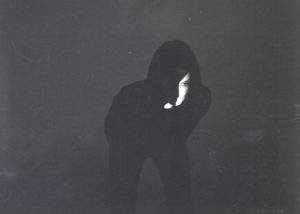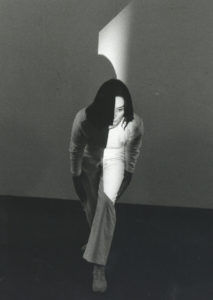Dawn Leach on
Nan Hoover
The compilation Nan Hoover 1974-1975 was purchased from the Jurka Gallery in Amsterdam and was the first of ten copies sold by the gallery. It is now part of the video collection of the Ludwig Forum für Internationale Kunst, Aachen (formerly the Neue Galerie – Sammlung Ludwig, Aachen). The title page reads: NAN HOOVER / 1974 – 1975. The final page reads: “CONVERSATIONS” / “ENCLOSURES” / “LIGHT PIECES” / CAMERA – SOUND / NAN HOOVER. The credit page reads: V.T. MONTAGE / JAN VAN DOMMELEIN / TeleVizier / AMSTERDAM
Conversations, in: Nan Hoover 1974–1975, video stills © Nan Hoover Foundation
The video Conversations contains six sequences. They are accompanied by different sounds that range from humming voices, pre-verbal utterances, gibberish noises, and a mechanical ticking to an alarm clock ringing. At the beginning we see a loosely configured ball of thread. Behind it and filling the upper left side of the screen is a white bristol board. In a statement in 1975, Hoover writes that she used bristol board “as a form to isolate an area of light.”[1] From behind this white plane, fingertips appear from above. The fingertips begin to pull playfully at threads in the ball. In the next scene, we see three fingers behind what might be the configuration of thread in the scene before. The movement of the fingertips almost mimics talking lips, and the painted lips in the background are thus overlaid with movement in time. Next, the lower half of the head of a person appears. It is lit from below and seen in profile; the person’s mouth is opening and closing but it is not in sync with the sounds. It is positioned in front of a painted profile. A second painted profile appears. Then the camera shows both a male profile on the left and a double female profile on the right. We see different views and portions of the female presence in front of the painted female image. Both profiles appear behind an opaque dark surface blocking out portions of the scene and restructuring the visual plane. At some point it becomes clear that the female in the foreground is raising her left arm, which is clothed in black, and moving it to obscure parts of the scene. This movement underscores the structuring of our visual field with white and black areas broken up by shades of gray.
Enclosures, in: Nan Hoover 1974–1975, video stills © Nan Hoover Foundation
In Enclosures the person of the artist is withdrawn from identification while the miming of expressive gestures, the materiality of props, and the role of light dominate the performance. “Enclosures,” Hoover writes, “are in two parts, the black series and white series.”[2] The alarm clock ringing in Conversations is repeated at the onset of the second video piece in the compilation. From a frog’s perspective we see a monumental white form. Above it we see a head with eyes blindfolded in black. Hands appear, reaching up from the upper edge of the white bristol board which encloses the body. A simple refrain is playing in a high pitch while a low-key pneumatic-type intake/exhaust sound structures the visual variations of light and shade reflected and blocked out to create dramatic and subtle patterns and shapes. The bristol board is held below the face; the mouth utters barely audible groans. The camera switches from the frog’s perspective to a close-up; the nose and lips are recognizable. Then a face with white greasepaint and a vaguely Dutch-shaped woman’s white headdress appears within the enclosing bristol board. Toward the end of this sequence, the pneumatic throb ceases. It is replaced by creaking. In this compilation the video continues with the first seven minutes of a segment of Light Pieces, which can be seen in both the Jurka Gallery catalogue stills and in the seventeen-minute version in the Videothek, Neuer Berliner Kunstverein (n.b.k.).[3] Two stills of the last sequence of Conversations are also ascribed to Light Pieces.[4] The bristol board, rolled up and channeling our view, enclosing as it were the hand and features of the face, draws attention to the similarity to Enclosures. Unfortunately, the same compilation (object no. 1455, 40 min.) in the Nan Hoover Estate is in need of conservation and cannot at present be viewed in order to make a comparison.
Light Pieces, in: Nan Hoover 1974–1975, video stills © Nan Hoover Foundation
The version of Light Pieces in the collection of the Ludwig Forum begins with the artist dressed in white and wearing a black band or cap on her head. Her changing movements catch and modulate the light in shades of gray. Rolls of bristol board are used as props, and the direction of the light source offers the viewer varying perspectives. The sound of running water is incongruous and disconcerting. Cut. Now we are presented with the artist dressed in black. Her shoulder-length black hair is visible and she is standing in front of a white background. The lighting is such that only her outstretched hand is illuminated; it moves toward the camera and conceals her face. Slowly the hand closes and moves to the face. Cut. Now the artist’s nose, lips, and chin and three fingers appear in dark surroundings; they are offset by a white backdrop to the right of the screen. Slowly the fingers move up the side of the face and conceal the profile.
Of the three works in this compilation, Conversations is probably the earliest and definitely the least well-known of the three. The first ninety seconds of Conversations appear to be identical with the video Threads (1974/75, n.b.k. object number H 017 02). This suggests that it could be pre-recorded material. The montage credits at the end of the compilation could be interpreted in this way. But the fact that Hoover’s camera could not simultaneously record image and sound meant that she had to rely on a sound studio.[5] Thus, it is also possible that the montage credit refers only to the sound. And who is to say whether the videotape Threads was finished before Conversations?

Invitation to the exhibitions Nan Hoover. Fotostücke. Videostücke, Neue Galerie – Sammlung Ludwig, Aachen, September 12 – October 6, 1981 (right) and Mac Adams. Der Mond unter dem Kronleuchter und andere Bilder. Installationen. Fotostücke. Zeichnungen, Neue Galerie – Sammlung Ludwig, Aachen, September 12 – October 6, 1981 (left)
Conversations not only contains threads as a material prop but also relates back to a prop in Hoover’s first performance. As Enno Develing explains, it involved using a long piece of rope that she would play with.[6] Hoover also tried to involve her spectators in her activities, writes Develing. The playful handling of a piece of rope lends itself to children’s pastimes—jumping rope and perhaps singing, too. However, in binding herself to a chair in her first performance, the playful element becomes an entanglement and relates to the motif of at least one painting from the early seventies (no title, 1971, oil on canvas, 65.5 x 60.5 cm, signed verso, CRW_5439 NHF collection of the Nan Hoover Estate). The painting depicts a standing naked male figure with his head and shoulders leaning forward. Orange coils connect his mouth and upper torso while a length of the same coil is held in his left hand. It is wrapped around his penis and dangles from his right hand to the bottom of the canvas frame. He has shoulder-length dark hair. Two orange lines can be seen behind his back and extend to the right edge of the canvas. The background is in flat olive green. Linear contour lines and details of the body hair are drawn in a graphite color. Hans Redeker describes his encounter with Hoover’s paintings and drawings at the Biesj Gallery, Amsterdam, as “quite significant”: “Nan Hoover has developed her own critical and poignant view of contemporary life and has lent to her form language the essence of a protest by means of the lines with which she presents the people of today.”[7] His following words would most likely apply to another painting of the next year, 1972: “It is mainly the contour line which reduces her human being to his naked truth: in the banality, the slander, the gossip, that goes from mouth to mouth and is devoured … without these grim deformations becoming overdone and defeating their purpose.”[8]
The backdrop of the scenes following the thread sequence is actually the painting Glass Eyed Man (1972, oil on canvas, 73 x 92 cm, signed verso, CRW_5460 NHF collection of the Nan Hoover Estate) by Nan Hoover. The wide format and the distanced face-to-face position of a male and female figure allow Hoover to double as a real presence in the video with the female figure. Furthermore, they allow her to draw an analogy to a conversation between the figures. The glass eye and the camera lens through which the scene is depicted also insinuate an associative similarity much as a verbal simile would. Here, Hoover’s often-cited insistence that she is a painter is actively evoked.
Postcard sent by Nan Hoover to Wolfgang Becker, Wolfgang Becker Archive
Enclosures on the one hand, and Light Pieces on the other hand, were the subject of the first catalogue devoted to her video work.[9] There, she writes: “I work with video much as I painted, in the sense that I work completely alone, setting up my lights, camera, and recorder: controlling the compositions by a monitor. I regard myself as an object that I move. At the moment I feel ready to record, the camera is turned on with my hand or foot. In the early pieces, I used my paintings as a ‘second profile’ sometimes speaking to or moving in front of the profile.”[10]
As noted above, the sequences in both of these works differ from others in public collections and publications. This variability is, however, not surprising. The compilation Movements in Light, which was put together for documenta 6, included Light Pieces 1, 2, 3. Hoover’s statement in the catalogue explains her video practice and her intended effect. Loosely translated, she writes the following: “When I move very slowly in the light, my body becomes an abstract image by means of light nuances. Gradually the abstract image takes on body. The image results in a body. The picture emerges from the references between abstraction and body, nature and body, body and landscape.”[11]
Postcard sent by Nan Hoover to Wolfgang Becker, Wolfgang Becker Archive
In the Nan Hoover estate, object number 1411 is named Light Pieces (1975, videotape, Sony small open reel, b/w, silent, 17 min.). While Conversations and Enclosures display expressive and mimicry effects, Light Pieces already points to the subtle nuances her later work will show. Within two years, critics will note that the visible body creates “dimensional perception changes, raises through repetition the subliminal to the surface and generally elevates the mundane to visual, textural mythologies …”[12] In contrast to the Jurka Gallery catalogue, the Stedelijk Museum Amsterdam’s catalogue shows two stills of Light Dissolves no. 1 which could be from Light Pieces, so close are they to sequences in the Ludwig Forum compilation.[13] By 1981, the strong bond of content and formal aspects of the medium video in respect to—in the case of Conversations—painting may have contributed to this early piece’s loss of enthusiasm on the part of its author. Not until Watching Out – A Trilogy (1986) did she again incorporate another medium into her video. This time it is a drawing that is no longer associated with her linear style but rather is bold and dynamic.
It will be obvious from the above that the current practices in performance and in particular that form referred to as “body art” well describe the pieces in this compilation. These were very much en vogue in the seventies and received widespread support in the “alternative spaces” scene. In Nan Hoover’s case, the networking and promotion of De Appel in Amsterdam provided her with a platform for experimentation. As Marge van Mechelen notes in her book about De Appel, Nan Hoover had sought out Wies Smals at Galerie Seriaal on hearing about the plans for De Appel. Up to then Hoover had been working in total isolation and, as Mechelen writes, “producing a number of videos without being aware of what was going on in this field. Since there was no suitable exhibition space available, Hoover showed her first tapes in 1974 in Amsterdam bars, where she was working part-time, but after the establishment of De Appel that was no longer necessary.”[14] Videotapes by Bruno Demattio, Christof Kohlhöfer, Darcy Lange, Ernst Mitzka, Dennis Oppenheim, Charlemagne Palestine, and Ulrike Rosenbach were shown during De Appel’s video week (1976). Hoover’s live video performance Light Shapes (1976), in which she again used bristol board, was performed at De Appel, and under De Appel’s auspices two further video performances were produced in 1977: Body / Light and Light Dissolves no. 2. Hoover made a large number of videotapes during these years and generally she used a macro lens. Her deliberate use of the macro range enabled her to present transitions from figure to ground that often only reveal themselves to the viewer as such when the outlines and volumes of light and movement offer identifiable glimpses of the artist’s body. As early as 1979, Hoover would express her hope to stimulate rather than dominate the viewer’s imagination with her video pieces. This was the beginning of a participatory aesthetic that would later lead to interactive light and video installations and environments.
In an article written in Dutch by Marge Bijvoet, Nan Hoover’s performance Extensions (1978) and her videotapes were singled out as “light works.”[15] The categories of light, sound, video, and other materials plus formal aspects are considered, and artists such as Vito Acconci, Michael Asher, Jan Dibbets, Robert Irwin, Bruce Nauman, Max Neuhaus, Maria Nordman, Eric Orr, Keith Sonnier, James Turrel, and Douglas Wheeler are discussed. It is noted that slow movement characterized all Hoover’s works and gave them a meditative character.
Friedemann Malsch acknowledges that with the second version of Hoover’s videotape Impressions (1978) she had established “her signature style, one that would mould her work in all media for the coming ten years.”[16] According to Malsch, Halfsleep (1984) brought Hoover her first international acclaim and went on to be included in all international video festivals and was also shown on Dutch television.[17] On more than one occasion, Hoover comments that her video work grew in tandem with the technological developments.[18]
[1] Nan Hoover, Nan Hoover: Enclosures / Light Pieces, exh. cat., Galerie Jurka, Amsterdam, 1975, unpaged.
[2] Ibid.
[3] Ibid.
[4] Ibid.
[5] See Friedemann Malsch, “Nan Hoover: Für mich bedeutet Video Licht; ein Gespräch von Friedemann Malsch,” Kunstforum International, vol. 98, January / February, 1989, pp. 127–128.
[6] Ulrich Bischoff and Enno Develing, Gesignaleerd Neue Kunst aus den Niederlanden, ed. Jens Christian Jensen, trans. Birgit Hansen and Jens Köhler, exh. cat., Kunsthalle Kiel, 1983, p. 90.
[7] Hans Redeker, “Nan Hoover,” Algemeen Handelsblad, September 1, 1970.
[8] Ibid.
[9] See note 1.
[10] Ibid.
[11] Nan Hoover, “Nan Hoover,” documenta 6, ed. Manfred Schneckenburger, exh. cat., vol. 2, Kassel, 1977, p. 344.
[12] Marsha Lore, “Nan Hoover, New Super 8 Films and Video,” Artzien, vol. l, no. 4, February 1979, unpaged.
[13] Nan Hoover, ed. Dorine Mignot, exh. cat., Stedelijk Museum, Amsterdam, 1979, pp. 2–3.
[14] Marga van Mechelen, De Appel: performances, installations, video, projects 1975–1983, De Appel, Amsterdam, 2006, p. 280.
[15] Marga Bijvoet, “Waarneming als kunst,” Museumjournaal, series 24, no. 1, February 1978, p. 18.
[16] Nan Hoover: Blue Mountain, Australia, ed. Friedemann Malsch, exh. cat., Museum Folkwang, Essen, 1989, unpaged. Author’s translation.
[17] Friedemann Malsch, “Nan Hoover,” Künstler-Videos: Entwicklung und Bedeutung: Die Sammlung der Videobänder des Kunsthauses Zürich, ed. Ursula Perucchi-Petri, Kunsthaus Zürich, Zurich, 1996, p. 137.
[18] See note 5.
